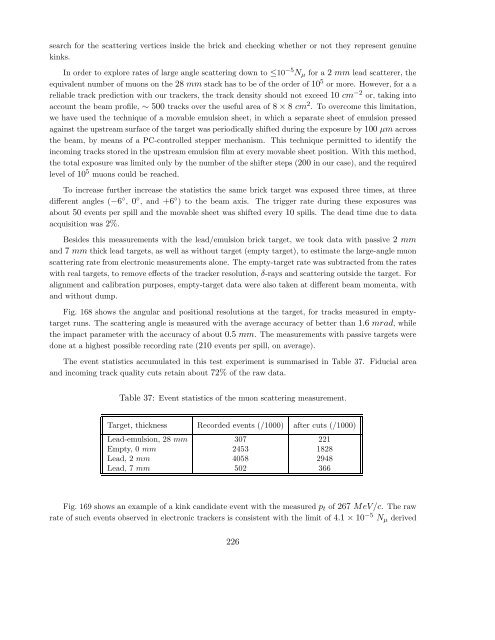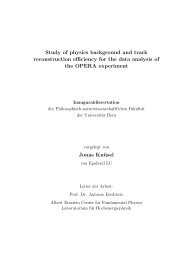Experiment Proposal - opera - Infn
Experiment Proposal - opera - Infn
Experiment Proposal - opera - Infn
Create successful ePaper yourself
Turn your PDF publications into a flip-book with our unique Google optimized e-Paper software.
search for the scattering vertices inside the brick and checking whether or not they represent genuine<br />
kinks.<br />
In order to explore rates of large angle scattering down to ≤10 −5 N µ for a 2 mm lead scatterer, the<br />
equivalent number of muons on the 28 mm stack has to be of the order of 10 5 or more. However, for a a<br />
reliable track prediction with our trackers, the track density should not exceed 10 cm −2 or, taking into<br />
account the beam profile, ∼ 500 tracks over the useful area of 8 × 8 cm 2 . To overcome this limitation,<br />
we have used the technique of a movable emulsion sheet, in which a separate sheet of emulsion pressed<br />
against the upstream surface of the target was periodically shifted during the exposure by 100 µm across<br />
the beam, by means of a PC-controlled stepper mechanism. This technique permitted to identify the<br />
incoming tracks stored in the upstream emulsion film at every movable sheet position. With this method,<br />
the total exposure was limited only by the number of the shifter steps (200 in our case), and the required<br />
level of 10 5 muons could be reached.<br />
To increase further increase the statistics the same brick target was exposed three times, at three<br />
different angles (−6 ◦ , 0 ◦ ,and+6 ◦ ) to the beam axis. The trigger rate during these exposures was<br />
about 50 events per spill and the movable sheet was shifted every 10 spills. The dead time due to data<br />
acquisition was 2%.<br />
Besides this measurements with the lead/emulsion brick target, we took data with passive 2 mm<br />
and 7 mm thick lead targets, as well as without target (empty target), to estimate the large-angle muon<br />
scattering rate from electronic measurements alone. The empty-target rate was subtracted from the rates<br />
with real targets, to remove effects of the tracker resolution, δ-rays and scattering outside the target. For<br />
alignment and calibration purposes, empty-target data were also taken at different beam momenta, with<br />
and without dump.<br />
Fig. 168 shows the angular and positional resolutions at the target, for tracks measured in emptytarget<br />
runs. The scattering angle is measured with the average accuracy of better than 1.6 mrad, while<br />
the impact parameter with the accuracy of about 0.5 mm. The measurements with passive targets were<br />
done at a highest possible recording rate (210 events per spill, on average).<br />
The event statistics accumulated in this test experiment is summarised in Table 37. Fiducial area<br />
and incoming track quality cuts retain about 72% of the raw data.<br />
Table 37: Event statistics of the muon scattering measurement.<br />
Target, thickness Recorded events (/1000) after cuts (/1000)<br />
Lead-emulsion, 28 mm 307 221<br />
Empty, 0 mm 2453 1828<br />
Lead, 2 mm 4058 2948<br />
Lead, 7 mm 502 366<br />
Fig. 169 shows an example of a kink candidate event with the measured p t of 267 MeV/c.Theraw<br />
rate of such events observed in electronic trackers is consistent with the limit of 4.1 × 10 −5 N µ derived<br />
226




